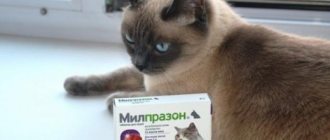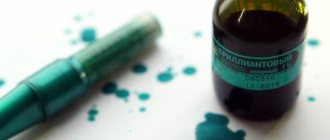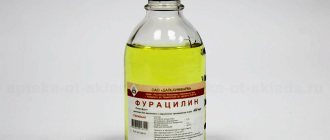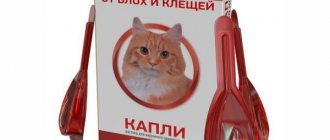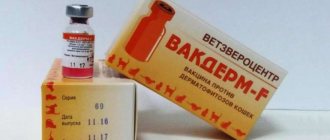Antibiotics for cats are medications that destroy pathogenic bacteria. Medicines can be natural or synthetic. During the period of taking an antibacterial drug, the animal’s body is cleansed of pathogenic bacteria, fungi and protozoa. This category of medications can be used both for therapy and for prevention purposes. Below you can find the most effective antibacterial agents used by veterinarians.
Is it possible to give antibiotics to cats?
It is possible to give antibiotics to cats, since the animal’s immunity cannot always cope with infections.
If a pet feels unwell due to an infectious disease and refuses food and water, it needs help in the form of antibiotics that can suppress the activity of pathogenic bacteria. Antibiotics for cats are used in the following cases:
- the presence of purulent wounds;
- the occurrence and progression of infections of the upper and lower respiratory tract, digestive and urinary systems;
- the presence of symptoms of eye and ear diseases of bacterial etiology;
- Antibiotics may also be used to prevent infection after surgery.
When antibiotics don't work:
There are several different reasons why antibiotics may not be effective in treating your cat's infection:
— Cleanliness of the wound : if the wound is not completely clean, antibiotics may not penetrate well and do their job. Think of it this way: you should thoroughly clean your own cuts and scrapes before applying antibacterial cream.
— Incorrect treatment : Sometimes even veterinarians may have difficulty identifying the correct antibiotic to treat a given infection. If the infection does not go away after a full cycle of antibiotics has been given, it may be a sign that the infection is a little different than what the vet originally thought and a different medication is required.
— Drug-resistant infection : Some infections are drug-resistant, and antibiotics cannot attack or suppress the microorganisms causing the problem.
- Incorrect dosage : Incorrect dosage, either too strong or too weak a medication, can interfere with your cat's treatment.
Side effects after using antibiotics for cats
The following side effects often occur as a result of the use of antibiotics:
- Reactions associated with individual sensitivity. They arise due to the entry of certain substances into the body and do not depend on the amount of medication administered or eaten. The severity of the lesions ranges from mild skin changes and vomiting to anaphylactic shock and death of the pet.
- Direct toxic reactions, depending on the amount of the drug administered or consumed and the duration of the treatment or prophylactic course. These side effects include damage to the kidneys, liver and other internal organs.
- Reactions associated with the biological effect of the medications used. This group of side effects includes the development of dysbacteriosis, diarrhea, impaired vitamin metabolism, and suppressed immunity.
What is an antibiotic and how does it work?
Antibiotics are substances that have a damaging or destructive effect on bacteria.
Each group of antibiotics has its own “methods of influence” on bacteria. Some cause the destruction of the membranes that protect the bacterium; some disrupt bacterial metabolism. Since the structure of a bacterial cell and a cell of a human or animal body is very different, antibiotics exhibit their destructive effect only in relation to bacteria. For example, an antibiotic that disrupts protein synthesis in a bacterial cell will not be able to disrupt it in an animal cell.
Contraindications for the use of antibiotics for cats
Antibiotics cannot be used if the animal is allergic to the components included in the composition. It is recommended to familiarize yourself with other contraindications by reading the instructions for use. Each medicine has its own characteristics.
Contraindications for cats that the most commonly used drugs have:
- Convenia – periods of pregnancy and feeding of kittens, age less than 8 weeks;
- Sinulox – hypersensitivity to β-lactam antibiotics;
- Amoxicillin – neonatal period, severe dysfunction of the liver and kidneys;
- Baytril - nerve damage, manifested by convulsions, significant disturbances in the development of cartilage tissue, age less than 2 months;
- Cobactan – hypersensitivity to β-lactam antibiotics;
- Ronaxan - periods of pregnancy, feeding kittens and dental development, severe disturbances in the functioning of the liver and kidneys;
- Ceftriaxone – hypersensitivity to cephalosporins, renal or liver failure;
- Tylosin – hypersensitivity to the main component;
- Tsiprovet - drops are not prescribed to kittens under 7 days old, tablets and solution are not recommended for pregnant, lactating cats and kittens under 1 year of age;
- Amoxiclav – hypersensitivity to amoxicillin, clavulanic acid.
Isn't the dose too high?
Antibiotic dosages may differ between humans and animals. This is due to the metabolic characteristics of animals. Therefore, it is quite possible that a medium-sized dog will be prescribed a “human” dose of an antibacterial drug. In addition, for certain diseases the dose can be reduced or, conversely, increased.
If you feel that your pet has been prescribed too much or too little of an antibiotic, discuss this issue with your doctor. You should not increase or decrease the amount of the prescribed drug on your own. This may reduce the effect of treatment or even complicate the disease.
Use of human antibiotics for cats
Veterinary drugs are preferable. However, if necessary, human medications can also be used. A cat can be given an antibiotic intended for humans, but only when it is not possible to go to a veterinary clinic and when the animal quickly weakens and begins to refuse food.
The following human antibiotics can be given to cats: Penicillin, Ampicillin, Oxacillin, Chlortetracycline, Doxycycline, Aquatil, Streptomycin, Gentamicin, Kanamycin, Amikacin, Levomycetin, Levonisol, Syntomycin, Iruksol.
Before starting treatment, it is recommended to read the instructions. It indicates the active substance and its quantity in capsule, solution and other dosage forms. Next, you need to find how many mg or ml of active substance are needed per 1 kg of human body weight. This information may be indicated in the instructions or in special reference books. To find out how much of the drug a cat needs, you need to multiply the found dosage by the pet’s weight.
For example, there is an antibiotic in tablets containing 100 mg of active ingredient. The instructions indicate the dosage - 5 mg/kg per 1 dose. If a cat weighs 4 kg, then he will need 20 mg of the drug, i.e. 1/5 of the tablet. If a kitten needs an antibiotic, then you should look in the instructions or reference book for the dosage suitable for children and, based on it, make a calculation.
Types of broad spectrum antibacterial agents
Broad-spectrum antibiotics include those that are active against more than 1 type of pathogen.
Antibiotics are effectively used to destroy bacterial, protozoan and fungal microflora in cats
According to the method of introduction into the body, antibiotics for cats are divided into means for local and general use.
Local ones include:
- ointments;
- aerosols;
- candles;
- drops;
- gels.
Common ones include:
- injection solutions;
- pills;
- capsules;
- suspensions.
By the way of influencing pathogenic microorganisms, antibacterial drugs are of 2 types:
- bactericidal (causes the death of bacteria);
- bacteriostatic (prevent the proliferation of pathogens, gradually leading to their extinction, and remove their waste products).
In some diseases, such as staphylococcal urethritis, the use of bactericidal agents is contraindicated, since the massive death of the bacterial population can block the lumen of the urethra and cause urolithiasis.
In case of sepsis, when the clock is ticking, on the contrary, only bactericidal drugs can save the life of the animal.
TOP 10 best veterinary antibiotics for cats
There are several antibacterial drugs that are most commonly used in the field of veterinary medicine. You should not choose a medicine from this list on your own. Only doctors can make the right choice. To make a diagnosis and prescribe treatment, specialists carry out the necessary tests, identify pathogens, and select antibiotics that are sensitive to the detected microorganisms. The age and weight of the animal and the presence of concomitant diseases are also taken into account.
Cats can be given both veterinary and human antibiotics: Convenia, Sinulox, Amoxicillin, Baytril, Cobactan, Ronaxan, Ceftriaxone, Tylosin, Ciprovet, Amoxilav.
Antibiotics should be given to your cat according to the instructions for the specific drug. Average time: 5-10 days.
Antibiotics in tablet form are given to cats along with food or orally, placed on the root of the animal's tongue.
Antibiotics are injected into the cat subcutaneously at the withers or intramuscularly.
Cats with colds can be given antibiotics: Azithromycin, Amoxiclav, Amoxicillin, Gentamicin.
Convention for cats
Convenia is part of the group of third-generation cephalosporins and has a prolonged effect. It is sold in powder form. The packaging contains bottles not only with this product, but also with a diluent. The active substance in the composition is cefovecin.
Convenia is intended for the treatment of various pathological processes caused by gram-positive and gram-negative bacteria.
Indications for use of Convenia:
- skin diseases;
- soft tissue damage;
- kidney and bladder diseases.
Cefovecin in 852 mg packaging is dissolved in 10 ml of diluent, in 340 mg packaging - in 4 ml of diluent. The prepared drug is administered once subcutaneously into the withers at the rate of 1 ml (80 mg of cefovecin) per 10 kg of cat weight. If necessary, the injection is given again after a 2-week period. The treatment course should contain no more than 4 subcutaneous injections.
The convention is not recommended to be combined:
- with furosemide;
- ketoconazole;
- non-steroidal anti-inflammatory drugs;
- drugs that have a high level of binding to plasma proteins.
Sinulox for cats
Sinulox refers to penicillins in combinations. It is produced in tablet dosage form. The composition contains 2 active ingredients – amoxicillin and clavulanic acid. Indications for use in cats: treatment of skin and respiratory infections, urinary tract infections, enteritis, prevention of infection after sterilization.
Sinulox is given to the pet by hand or mixed with food for 5–7 days. The dose for one dose is 12.5 mg per 1 kg of cat weight. Frequency of use – 2 times a day.
For example, if the Sinulox package contains 50 mg tablets, the dosage for one dose depending on the weight of the animal will be as follows:
- up to 2 kg – ½ tablet;
- from 3 to 5 kg – 1 tablet;
- from 6 to 9 kg – 2 tablets.
It is not recommended to give cats bacteriostatic antibiotics at the same time with Synulox.
Amoxicillin for cats
Injectable amoxicillin is an antibiotic related to penicillins. It is available in the form of a suspension for injection under the skin or into muscles. The main component is amoxicillin trihydrate.
Indications for use include various infections:
- stomach and intestines;
- organs of the respiratory system;
- joints;
- urinary system;
- skin and soft tissues.
The recommended dosage for injection under the skin or muscle is 1 ml per 10 kg of pet weight. The maximum volume of medication for administration in one place is no more than 5 ml for a cat. Amoxicillin injection is given once. If the effect is insufficient, the suspension is re-administered 2 days after the first injection.
Amoxicillin should not be used simultaneously with a number of antibiotics - penicillins, cephalosporins, fluoroquinolones, bacteriostatic agents, thiamphenicol, chloramphenicol. It is also not recommended to mix this medicine and other medications in one syringe.
Baytril for cats
Baytril for a wide spectrum of action is produced in the form of a solution with a concentration of 2.5%. The active substance is enrofloxacin.
The use of Baytril is recommended:
- with intestinal inflammation;
- urolithiasis;
- infectious diseases of the respiratory and urinary systems;
- septicemia;
- salmonellosis;
- colibacillosis;
- streptococcosis;
- various mixed infections.
Baytril solution is intended for injection under the skin. Dosage for an adult cat is 0.2 ml of antibiotic with a concentration of 2.5% per 1 kg of animal weight once a day. Do not inject more than 2.5 ml into one place, as the pet may feel severe pain. The recommended duration of the treatment course is from 3 to 10 days.
Baytril cannot be used simultaneously with antibiotics related to macrolides and tetracyclines. Also, you should not combine the solution with chloramphenicol. During treatment with Baytril, it is undesirable to give Theophylline and non-steroidal anti-inflammatory drugs.
Cobactan for cats
Cobactan is a potent medication classified as a cephalosporin. It is available in the form of an injection suspension. The active substance in the composition is cefkinoma sulfate.
Cobactan labeled 2.5% was originally developed for the treatment of diseases of bacterial etiology in pigs and cattle, but later the suspension was additionally prescribed to small pets.
Cobactan is recommended to be used only if other antibiotics for cats have not had the desired effect. The medicine is administered intramuscularly once a day for 2–5 days. The approximate amount of antibiotic is 0.5 ml per 5 kg of weight of an adult cat. The exact dose suitable for your pet must be determined by your doctor.
Cobactan should not be combined with drugs that have a bacteriostatic effect. Otherwise, you may encounter a decrease in the bactericidal activity of the antibiotic used.
Ronaxan for cats
Ronaxan belongs to the group of tetracyclines. This drug is commercially available in tablet dosage form. The active ingredient in the composition is doxycycline.
The tablets effectively weaken and destroy various gram-positive and gram-negative microorganisms, as well as chlamydia, rickettsia, spirochetes and mycoplasmas. In this regard, the antibiotic has a wide range of uses. Veterinarians prescribe Ronaxan for purulent wounds, colds, rhinitis, tonsillitis, and bronchopneumonia in cats. The product can also cope with cystitis, pyelonephritis, prostatitis, and endometritis.
Method of administration: orally, placed on the root of the animal’s tongue. Ronaxan can also be given to your cat with her usual food. Dose – 10 mg per 1 kg of pet’s weight. Duration of treatment is from 3 to 5 days for acute forms of the disease and from 8 to 10 days for chronic forms.
Drugs with which Ronaxan is not recommended to be used simultaneously:
- bactericidal antibiotics of the cephalosporin and penicillin groups;
- barbiturates;
- phenytoin;
- medicines and feed additives containing salts of aluminum, iron, magnesium, calcium.
Ceftriaxone for cats
Ceftriaxone is a cephalosporin. It contains the active ingredient of the same name. Ceftriaxone is available in the form of a powder for the preparation of a solution and is intended for intramuscular administration.
Indications for use: treatment of various infectious diseases. The dose and method of dilution must be determined by a doctor.
Example use of ceftriaxone (if the cat weighs 3.5 kg):
- take a bottle with 500 mg of Ceftriaxone;
- dilute the medicine using 2 ml of saline;
- draw 0.75 ml of Ceftriaxone and 0.25 ml of Ledocaine 2% into the syringe;
- give injections 2 times a day for 7–10 days.
Ceftriaxone is incompatible with bacteriostatic antibiotics. They reduce the bactericidal effect.
Tylosin for cats
Tylosin is an antibacterial drug from the macrolide group. Release form: solution for injection.
The active ingredient in the composition has the same name as the drug. The component weakens and causes the death of gram-positive microorganisms. It is also effective against some gram-negative bacteria.
Tylosin is prescribed for abscess, bronchopneumonia, and secondary infections that develop during viral diseases. When using the solution, it is recommended to pay attention to the concentration of the active substance. Tylosin 50 is administered intramuscularly at a dose of 0.1–0.2 ml per 1 kg of cat weight, and Tylosin 200 – 0.025–0.05 ml.
The medication cannot be used simultaneously with clindamycin, chloramphenicol, tiamulin, lincomycin. Also, you should not combine Tylosin with cephalosporins and penicillins.
Ciprovet for cats
Ciprovet is an antibiotic for veterinary use. One of the dosage forms is tablets. They are prescribed for cystitis and other diseases of the urinary system, infections of the respiratory system, gastrointestinal tract, biliary tract, joints, bones, skin and soft tissues. Dose – 1 tablet per 3 kg of cat’s weight. The medicine is given once a day for 3–5 days.
You should not combine bacteriostatic antibiotics, theophylline, non-steroidal anti-inflammatory drugs, or medications with calcium, magnesium and aluminum cations with Ciprovet.
Amoxiclav for cats
Amoxiclav is a combination drug containing amoxicillin and clavulanic acid. It has found application in the treatment and prevention of various bacterial infections.
The recommended dose is 12.5 mg per 1 kg of cat weight 2 times a day. The course of treatment is 7 days (can be adjusted by a doctor if necessary).
Features of calculating the dose of Amoxilav:
- First, you need to determine the basic single dose by multiplying 12.5 mg by the weight of the animal.
- Next you need to pay attention to the weight of the tablet. It can be 625 mg or 375 mg. The weight of the medicine must be divided by the base single dose. You will get a number that indicates how many parts the tablet should be divided into.
Amoxiclav can also be purchased in powder form for the preparation of an oral suspension. Packages may be labeled 312.5 mg/5 ml or 156.25 mg/5 ml. To calculate a single dose in ml, 12.5 mg should be multiplied by the weight of the animal and 5 ml. Then the resulting value must be divided by 312.5 or 156.25 (depending on what is indicated on the package).
Bacteriostatic antibiotics should not be combined with Amoxiclav.
Is it possible to take antibiotics for several months?
You can if necessary. Depending on the disease, the duration of antibiotic treatment can vary - from several DAYS to several MONTHS.
The doctor will tell you how long antibiotics will need to be used if your animal is ill, and what parameters he will use to decide whether to continue or stop antibiotic therapy. For example, chronic cystitis requires long-term use of antibiotics. At the same time, a urine test is done every few weeks to determine when the drug can be stopped.
The important fact is that the animal may no longer have clinical symptoms of the disease; to the owner it seems completely healthy. However, if the drug is stopped prematurely, before the tests return to normal, a recurrence (resumption) of the disease is possible. Relapses may be more difficult to treat. Long-term use of antibiotics is also indicated for bacterial skin infections.
What drugs enhance the effect of antibiotics?
On the recommendation of a veterinarian, you can use Wobenzym, an anti-inflammatory and immunomodulatory agent. It increases the concentration of antibiotics in the source of inflammation and in the blood plasma and thereby increases the effectiveness of the drugs used. The approximate dose is ¼ tablet.
You can also improve the effectiveness of antibiotics with the help of Glycopene. This is a special veterinary immunomodulator. It strengthens the body's resistance. As a result, the animal recovers faster. Single dose – 1/4–1/2 tablet for a cat weighing 1–3 kg or 1/2–1 tablet for a cat weighing more than 3 kg.
Why did the doctor prescribe an antibiotic to my animal?
- We list the cases in which the doctor may prescribe antibacterial therapy:
- Infectious diseases caused by bacteria. For example, a disease such as leptospirosis is caused by the bacterium Leptospira. An animal suffering from leptospirosis cannot be cured unless an antibiotic is used that kills leptospira.
- Any diseases accompanied by inflammation: cystitis, enteritis, cholangitis, otitis media, tracheitis - the list goes on and on.
- Bacteria can either cause inflammation themselves or complicate the course of other diseases.
- For example, with viral enteritis, the cause of inflammation of the gastrointestinal tract is viruses. However, due to the disruption of the natural protective barriers of the intestine, favorable conditions are created for the development of bacteria. This complicates the course of the disease and requires the inclusion of antibiotics in therapy.
- Oncological diseases also often require the inclusion of antibacterial drugs in therapy, since tumor-altered tissues create favorable conditions for the development of bacteria.
- Antibiotic therapy for injuries and surgical interventions.
- The skin protects the body from the penetration of bacteria. When it is damaged - cuts, bites - bacteria from the skin and environment enter the wound. In this case, the help of antibiotics is again needed.
- Antibiotics are not always used during surgical operations. If there is no inflammatory focus in the body, the operation is planned (for example, castration) and is performed in a sterile operating room, observing aseptic rules; antibiotics are not used at all or are used once before surgery.
This is just a short list of situations in which a doctor may prescribe antibiotics to an animal.
In any case, if you do not understand why the doctor prescribed an antibiotic, or you think that using an antibiotic if your animal is ill is unnecessary or harmful, do not stop the antibiotic yourself, discuss this with your doctor. Perhaps by canceling the antibiotic, you are complicating the course of your animal’s disease, or significantly slowing down recovery!
Treatment of antibiotic-associated diarrhea
Diarrhea that develops while taking antibiotics requires adjustment of the treatment regimen. You should not stop taking medications on your own; you should consult your doctor. Typically, the course of antibacterial therapy is interrupted or the drug is replaced with an antibiotic of a different group.
Normalization of digestive processes, intestinal motility and stool consistency are tasks that require an integrated approach. There are three general principles that are important for all people suffering from diarrhea after taking antibiotics:
- Nutrition correction: it is important to follow a diet. The diet should include crackers and rice water. It is important to reduce the amount of carbohydrates consumed as much as possible, and also give up milk, dairy products, baked goods, fresh vegetables, berries and fruits; legumes, pasta.
- Compliance with the drinking regime: it is necessary to drink at least 2 liters of water per day to replenish fluid loss during watery stools.
- Symptomatic therapy: the pathological process can be stopped with the help of medications.
Due to the fact that many sources of natural probiotics and prebiotics are prohibited for diarrhea, one of the key principles of treatment is the prescription of medications containing these components. Strict dietary restrictions require the use of probiotics and prebiotics for antibiotic-associated diarrhea: it is important to restore normal intestinal microflora to prevent the proliferation of opportunistic microorganisms.
In most cases, medication correction is indispensable. Remember that only a doctor can prescribe medications.
There are several groups of drugs that can be recommended for antibiotic-associated diarrhea.
Sorbents
Infectious and inflammatory diseases are accompanied by intoxication of the body, and in the process of antibacterial therapy, decay products of pathogenic microflora accumulate. Therefore, the doctor may prescribe enterosorbents - products that literally absorb toxins and harmful substances and remove them from the body.
Probiotics and prebiotics
It is important to address the root cause of diarrhea and restore normal intestinal microflora after taking antibiotics. For this, probiotics are used - bifidobacteria, lactobacilli, as well as prebiotics - a nutrient substrate to stimulate the growth of one's own beneficial microflora. Synbiotics include both probiotics and prebiotics and are widely used in gastroenterological practice.
If there is a pronounced shift in the microbial balance, the doctor may recommend intestinal antiseptics or bacteriophages - they are designed to prevent the growth of opportunistic microflora and help restore the number of beneficial microorganisms.
Enzymes
Enzyme replacement therapy is not the mainstay of treatment for antibiotic poisoning. However, preparations based on digestive (pancreatic, gastric, intestinal) enzymes stimulate the digestion of food, normalize intestinal motility and peristalsis and participate in the restoration of normal microflora of the large intestine.
Symptomatic therapy
Diarrhea is often accompanied by painful symptoms: flatulence, nausea, cramping and abdominal pain. You can quickly alleviate the condition with the help of medications. They are unable to cope with the main problem, but will bring temporary relief. Report your symptoms to your doctor, and he will select one or more remedies to improve your well-being:
- for increased gas formation - defoamers (drugs based on simethicone) or herbal carminatives;
- analgesics or antispasmodics for pain;
- Oral rehydration solutions are products designed to replenish normal fluid volume and prevent dehydration.
If diarrhea is accompanied by elevated body temperature, the doctor will select an antipyretic drug.
General strengthening agents
Weakened by an infectious or inflammatory disease, as well as subsequent use of antibiotics, the body may require complex recovery. A specialist can prescribe immunomodulators, vitamin-mineral complexes and restorative drugs.
Restrictions in food during diarrhea can also cause hypovitaminosis and lack of minerals. During long-term antibiotic therapy, it is necessary to discuss preventive measures with your doctor in advance.
Antidiarrheal drugs
If you cannot cope with diarrhea, your doctor may prescribe drugs from the following groups:
- eubiotics - live bacteria that are designed to restore the balance of intestinal microflora and restore normal digestive function;
- synthetic drugs based on loperamide: bind to opioid receptors of the intestinal wall and inhibit the release of mediators that stimulate intestinal motility;
- herbal preparations based on tannins.
Sorbents also have an antidiarrheal effect. They are natural and synthetic. Enterosorbents, entering the intestines, absorb toxins and harmful substances, contribute to the formation of stools and their reduction. It is important to remember that at least two hours should pass between taking sorbents and other drugs.
For severe antibiotic-associated diarrhea, antibacterial agents targeting Clostridium difficile or another infectious agent may be appropriate.
The drug “Fitomucil Sorbent Forte” can be used as an adjunct to relieve diarrhea syndrome. It contains inulin, a prebiotic that promotes the growth of normal microflora, as well as 5 types of probiotic bacteria. In addition, the drug contains psyllium, a natural component that helps reduce diarrhea and relieve intoxication, since it turns into a gel and absorbs toxins. The triple effect (enterosorbing, detoxifying and restorative) distinguishes Fitomucil Sorbent Forte from other sorbents prescribed for AAD. Live bacteria populate the intestines and not only help relieve diarrhea, but also improve the condition of the microflora that has been damaged by taking antibiotics.
However, to restore microflora it is not enough to take one drug.
Only a doctor prescribes specific therapy. It is necessary to stop taking uncontrolled medications and agree with a specialist on medications for symptomatic therapy.
Strictly prohibited combinations of antibiotics
Not all antibiotics can be used at the same time. There are combinations that are strictly prohibited and can have serious consequences for your pet’s health!
Do not mix:
- Aminoglycosides and cephalosporins (the nephrotoxic effect increases, acute renal failure or nephritis develops).
- Nitrofurans and fluoroquinolones (full antagonists that cancel each other’s effects).
- Fluoroquinolones and cephalosporins (severe kidney damage (nephrotoxic effect), leukopenia).
- Sulfonamides and chloramphenicol (pharmacologically incompatible).
- Aminoglycosides, vancomycin, polymyxin with furosemide (a sharp increase in the toxic effect on the hearing organs until it is completely lost).
- Beta-lactam antibiotics and carbapenem (obvious antagonists).
- Cephalosporins (especially ceftriaxone) with calcium gluconate (especially in one syringe).
- Aminoglycosides (in particular gentamicin) and penicillin antibiotics cannot be mixed in the same syringe (antagonists, increasing the ototoxic properties of gentamicin). At the same time, combination therapy with different injections is welcome.
- Ceftriaxone and vikasol (complete neutralization of the effect of vikasol).
- Polymyxin, penicillin and cephalosporins (pharmacological incompatibility with each other).
Author:
Grinchuk Ekaterina Andreevna veterinarian
Side effects, contraindications
The most common side effect of antibiotics is a disruption of the intestinal microflora (dysbacteriosis). Drugs in this group have a detrimental effect not only on pathogenic, but also on beneficial microorganisms.
This side effect can be neutralized by the simultaneous intake of probiotics, which populate the intestines with the necessary microflora.
It is recommended to give them to the cat for another 2 weeks after completion of antibacterial treatment.
Other adverse reactions to taking antibacterial drugs may include:
- Allergy to the active substance or auxiliary component (rash, scratching on the skin, focal hair loss).
- Edema of an immunological nature.
- Spasms and convulsive contractions of muscles.
- Breathing disorders, up to suffocation.
- Vomiting, diarrhea, stomach pain.
Be sure to read:
Kvamatel for cats: instructions, indications, dosage, analogues and reviews
Antibiotics can affect the reproductive system , so at least 3 months should pass between the end of treatment and the mating of the cat. Otherwise, the offspring may be born with defects.
Antibiotics are used in the treatment of any infectious diseases.
If a cat has liver and kidney diseases, antibacterial drugs can cause their exacerbation.
In case of disturbances in the functioning of these excretory organs, taking the aminoglycoside monomycin is absolutely contraindicated, and in case of some skin diseases, bacteriostatic drugs such as chloramphenicol and syntomycin are prohibited.
The period of pregnancy and breastfeeding is also a contraindication to antibiotic therapy . Treatment of kittens should be carried out under the supervision of a veterinarian.
Can a cat treat a wound with iodine?
It is contraindicated to treat a purulent wound with iodine and brilliant green. If it does not fester, you can lubricate its edges with iodine without getting deep into the damage.
Before applying the medicine, it is necessary to clean the damaged area from hair and dirt. Dried pus can be softened using hydrogen peroxide (up to 3%), and the fur must be carefully cut off with scissors.
suitable for cleaning the injured surface .
